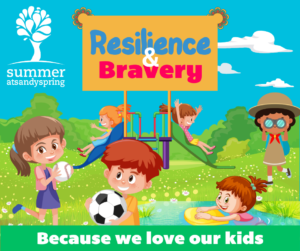Resilience & Bravery
How SaSS plays a part in helping children survive and even thrive.

In the past, humanity has placed an enormous amount of stock on being brave. Bravery can be defined as “the quality or state of having or showing mental or moral strength to face danger, fear, or difficulty.” That’s great; we often need to face hard or scary things. However, savvy parents know that it’s not about just having the mettle to face those fears, dangers, or difficulties. It’s about how we function after we face them, too.
Enter resiliency, which is defined by the American Psychological Association as “the process of adapting well in the face of adversity, trauma, tragedy, threats, or significant sources of stress.” Even under the most idyllic of circumstances, all children will experience a traumatic experience at some point in their childhood or adolescence that will require them to adjust and adapt in order to survive.
So what makes some children survive and others thrive, and how on earth does summer camp play into it?
First, there’s the innate motivation that all children have in early infancy and childhood. This was identified decades ago as the “mastery motivation system,” and you’ll have seen it when you watched your child light up just from interacting with their environment successfully. Throwing things off their high chair, watching them fall, and cackling as it happens? That’s actually related to motivation mastery. Taking their first steps and beaming at you with pure pride? That’s intrinsic motivation, and it can’t be taught or bought. Both internal agency and the absolute pleasure of accomplishment are vital to human development and serve as protective mechanisms for resilience. All children come hardwired with this to some extent.
But beyond the innate and genetic factors that influence resilience, there’s an enormous amount of research that shows that when we as caregivers and adults put forth our own best efforts in taking care of our children and teaching them appropriately, resiliency can be cultivated against any odds.
What does that look like? Educational researchers have found that a key component is the existence of positive partnerships between children, parents, teachers and staff, and community and health services. This is an innate part of the summer camp process at Summer at Sandy Spring. In order to leave your precious child with us all day, you have to trust our staff and administration and work collaboratively with us. Modeling that trust allows your child to have the same relationship and partnership. If children feel connected to the system they’re a part of, they’re guaranteed better positive social, emotional, and mental health outcomes.
Beyond that initial trust, how do we as camp staff, administration, and advisors imbue SaSS with methods to foster bravery and resilience?
Here are some ways that resiliency grows at SaSS:
1. We use scaffolding to teach bravery and address their fears in stages. Our adventure park and the adventure challenge, for example, don’t just throw children into the most intense skill (climbing, advanced zip-lining) on day one; children learn the park, the literal and metaphorical ropes, gain comfort, and build their skills day by day until they’re confident enough to tackle the most intense course.
2. We create opportunities for independence. Camp is the ideal place for building skills outside of the home setting. While children and adolescents are still under the watch and care of competent, supportive adults, they’re outside of their familiar home setting. They have free reign to develop independent skills and flex their bravery muscles.
3. Camp avoids escape. At home, children may be spooked by a new level on a computer game or frustrated with playing with their sibling and be able to immediately walk away, shut off, and go do something else. At camp, they’re forced to strategize and cope and find solutions. It’s not that they can’t get out of a scary task if they don’t want to, but letting kids immediately escape new or fearful situations actually validates their fears. Camp puts a buffer there that allows kids to welcome the unknown and become comfortable with what initially may seem unpleasant
4. We teach internal locus of control. Your children learn at SaSS that they personally can influence the outcomes of their struggles through hard work, perseverance, and play.
By sending your children to SaSS, you’re giving them an amazing time filled with joy and enrichment, but you can also feel confident that we’re building important skills that help them become resilient adults. Feels good to multitask, doesn’t it?





